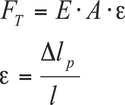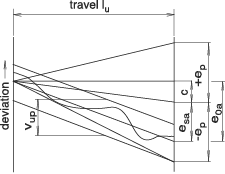Pre-Tensioning a Ball Screw
![[Translate to English:] Kontakt](/fileadmin/media/steinmeyer/kontakt.jpg)
Contact
Under +49(0)7431 1288-0 we are at your disposal.
Your desired size is not listed? We also manufacture individually. Give us a call!
The purpose to pre-tension a ball screw is to compensate for thermal expansion during operation and thus avoid compressive forces as the shaft expands between the two fixed bearings. The goal is to stretch the screw sufficiently to maintain at least some tension at the highest anticipated temperature.

Anticipating the temperature
Steinmeyer is capable of determining the steady-state temperature for your duty cycle. Please contact us for details.

Δt Temperature rise
α Coeff. of thermal expansion
ls Shaft length
Calculating the elongation
The elongation of the shaft should at least be equal to the thermal expansion for the anticipated steady-state temperature, or slightly larger.

Δlp Amount of elongation
ΔlT Thermal expansion
Calculating the tensioning force
Pre-tensioning requires considerable forces. In applications with rotating shaft, the support bearings have to withstand these forces, which becomes a main consideration for the selection of the bearings.

FT Tensioning Force
E Elasticity modulus
A Shaft cross section
ε Elongation relative to length
To calculate the tensioning force, assume that the root diameter of the screw is approximately the nominal diameter minus the ball diameter.
Technical Tip
There is only a minimal change in the resonant frequency (critical speed) of the shaft when tensioned. But tensioning is necessary when the screw is supported by fixed bearings at both ends. The fixed bearings do of course result in raising critical speed.

Ball screws may be ordered with a negative lead compensation c, so that after tensioning the lead deviation is near zero.
